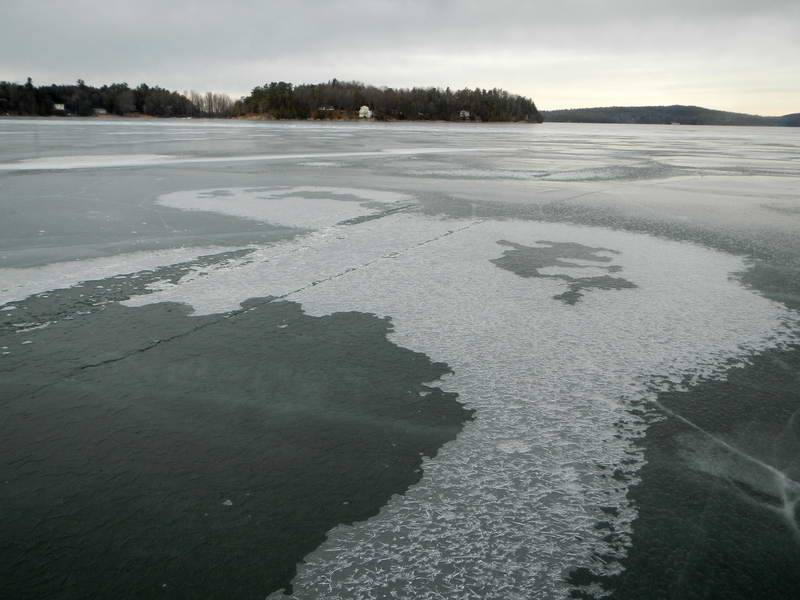Shell Ice
'Shell Is Hell' is iceboating slang for their lack of love for shell ice.
 Wet and dry shell ice. The wet shell is the dark ice in the lower left quadrant of the picture. This shell is about 1/16" thick.
Wet and dry shell ice. The wet shell is the dark ice in the lower left quadrant of the picture. This shell is about 1/16" thick.
Shell ice is a layer of ice that forms on top of a puddle. It is often widespread when it gets cold after a thaw has left puddles on the ice. It comes in two types
- Wet Shell Ice: Still has a puddle underneath. It usually looks a lot like new black ice.
- Dry shell ice: Has air underneath after the water drained away.
Wet shell ice lasts only until the water freezes all the way thorugh the puddle. Dry shell ice forms when the water drains away before the skin freezes all the way through. The dry shell is often held up with a network of thin crystals that form as the water drains. It often lasts until the next thaw.
Dry shell ice's white color makes it easy to spot, especially if you are not booking along at 40 mph in an iceboat. Skaters find it difficult to skate over and sometimes it is a tripping hazard. Poles and slow speed generally make skating across a moderate amount shell ice reasonable. Often it is relatively limited in extent but sometimes it is 80% of the surface of an ice sheet. When a skate blade or iceboat runner goes through it shatters the shell into many pieces (these can be very slippery, especially if you are on foot). It is noisy when skated over. It tends to keep a blade pointed in the direction it is pointed in.
Wet shell ice typically does not last very long but it can a hazard for iceboaters and skaters. The underlying water supports the shell enough that the runners cuts a narrow slot in the shell rather than shattering it . If the shell is the right thickness, it is strong enough to keep the runners from being turned meaning the boat can't be steered until it gets on more solid ice. This can lead to a crash. Stand up sailors can get violently pitched in some situations.
Wet shell ice is common around pressure ridges even when no thaw is involved. This is related to the compression buckling of the ice around the ridge. With an overlapped ridge the 'under' side of the crack often has a puddle that skins over. Fold down ridges can have deep skinned over puddles.
Broad depressed areas form on big ice that may only be a foot or so deep but are hundreds of feet long and several 10's of feet wide. They are most common when the ice has warmed significantly in the recent past and they are more common on bigger ice.
If you skate into one of these you are likely to trip and get very wet in the fall. In an iceboat you are likely to get very wet and a crash is possible. On an iceboard you are likely to get pitched. These broad puddles are sometimes hard to spot, especially if they have a skim of ice on them. They are often associated with pressure ridges but can be somewhat random as well.
Soufflé Shell Ice:
Sometimes when these deep puddles drain in cold conditions they can create a relatively unusual form of shell ice we have named 'soufflé shell ice'. This form of shell ice often is 6" to over a foot thick and typically has a crust on top and a supporting matrix of ice flakes underneath. The crust often partially collapses making a very irregular surface. Soufflé shell created a bit of a mystery in Newfoundland last winter.
Bob - September 2011 updated 12/3/13
